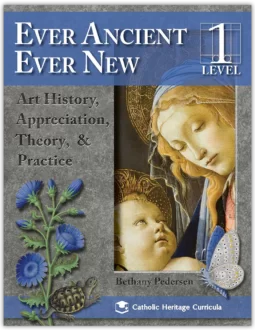Blue Mantle
Ever Ancient, Ever New: Art History, Appreciation, Theory, and Practice (Level 1)
Ever Ancient, Ever New: Art History, Appreciation, Theory, and Practice (Level 1)
Couldn't load pickup availability
“Late have I loved You, O Beauty ever ancient, ever new!” — St. Augustine
Ever Ancient, Ever New leads children to God by Benedict XVI’s “way of beauty.” Level 1 tells the “story of art” from cave artists to the High Renaissance masters, paying special attention to the way God speaks through art.
Discussion of each artistic period is accompanied by:
- Detailed picture studies of period masterpieces that teach students the “language of art”
- A lesson in art theory with a focus on the seven elements of art (line, shape, texture, form, value, space, and color)
Art Pad 1 provides homeschool-friendly art projects that teach fine arts skills while reinforcing and complementing the lessons in art theory and history from the text. Art Pad 1 includes:
- 35 weeks of easy-to-follow project instructions
- Projects themed to match the textbook
- Project templates on colored cardstock and artist’s paper
- Clear lists of additional, easy-to-find supplies
Ever Ancient, Ever New, Level 1 teaches:
- Art History: Cave Art, Egyptian, Greek, Roman, Early Christian, Byzantine, Celtic, Anglo-Saxon, Viking, Insular, Carolingian, Romanesque, Gothic, Early and High Renaissance Art
- Art Theory: Elements of art (line, shape, texture, form, value, space, and color), types of compositions (vertical, pyramidal, etc.); pattern; symbolism; picture space; positive and negative space; bilateral and radial symmetry; implied space, form, and texture; color theory; foreground, middleground, and background; linear perspective; and atmospheric perspective.
- Art Appreciation: Over 60 picture studies of masterpieces such as Andrei Rublev’s Three Angels, the Royal Portal of Chartres Cathedral, Fra Angelico’s Annunciation, and Leonardo da Vinci’s Last Supper
- Art Practice: Fine art skills such as using lines with different qualities, simplified human figure drawing, drawing facial features, mixing paints, creating textures with tooling foil, working with watercolors to create implied texture, drawing with linear perspective, painting with atmospheric perspective, sculpting and drawing the human form in action; creating implied space through overlapping and shading, and more
The author of Ever Ancient, Ever New is a practicing artist with an M.A. in theology and wrote her master’s thesis on sacred art in the theology of Joseph Ratzinger (Benedict XVI). She believes that all great art points beyond itself to God, the source of all beauty.
Age Level and Scheduling: Ever Ancient, Ever New, Level 1 is designed for fifth- and sixth-grade students, but can also be used by seventh- to ninth-graders. The program can be completed in either one or two years.
Share


